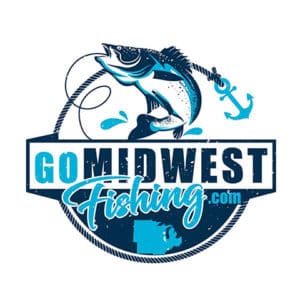I got invited to do some steelhead fishing on the Brule River in Wisconsin by some friends, so I jumped at the chance because it’s something I’ve never done before. I had so much fun, I’m already planning on going again next year. If you’re new to this type of fishing, or even if you’re not, keep reading as I reveal all I learned on my successful trip down the Brule river. To see the full video of our trip, I will post it at the bottom of this page.
Things you will need to know: What type of fishing pole and bait to use. How to select a good pair of waders. How to dress for the weather. When and where to go. Regulations, proper etiquette and much more.
What is a Steelhead?
A Steelhead is a rainbow trout that lives its life in a large body of water (Lake Superior in this case), and migrates into the rivers to spawn. The rainbow trout is not native to this area, but was one of the first non-native species to be stocked here over 100 years ago. It is originally from the Pacific Ocean and coastal streams from Mexico to Alaska and northeast Russia. It was introduced to the Great Lakes and southern Canada and eastern United States.
Rainbow Trout vs Steelhead
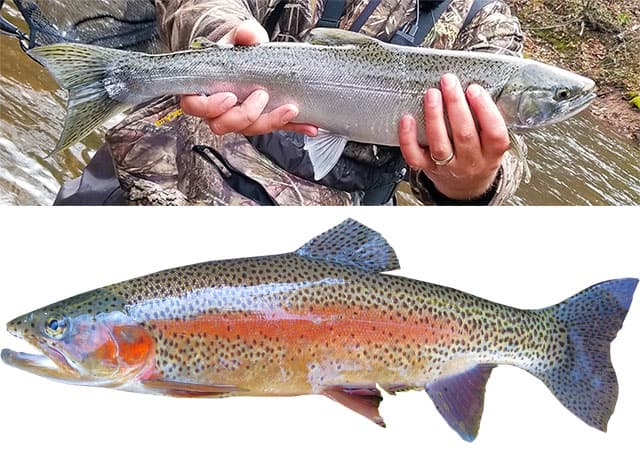
Rainbow Trout and Steelhead are genetically the same fish, but lead very different lives. So what determines if a Rainbow Trout will become a Steelhead? Researchers have been working on this answer and have yet to come up with a definitive answer, but have identified some genetic and environmental factors that may play a part in their decision.
Genetic: Steelhead were found to have a higher metabolic rate which can lead to lower energy conversion, resulting in lower lipid storage and a higher rate of anadromy (Meaning, the migration of fish). The resident population of Rainbow Trout had a higher fat content, suggesting that the availability of food is high, so there is no need to migrate.
Enviromental: Factors such as water temperature, stream flow and food abundance may also affect whether the fish decide to stay or go. It makes sense that if a fish has everything it needs, that it will stay right where its at, but if it’s lacking something, then it might migrate looking for more suitable habitat.
Appearance: Both fish start out looking the same. The Rainbow Trout grows up and gets an intense pink stripe and heavily spotted body. The Steelhead turns a silvery color and usually gets much larger, but much of its appearance depends on its age and habitat.
Selecting The Proper Fishing Pole For Steelhead

Spinning Rod: I have many spinning reels and rods to choose from, but it turns out, I needed to buy another one. There are many ways you can fish for steelhead, but I will first talk about the set up I used. Apparently my 7 and 8 ft rods were too short. What I needed was a 10.5 foot rod with a spinning reel spooled with 10 lb high visibility monofilament. I found a rod/reel combo at Cabelas for only $60! The rod said ultralight, but it had a good stiff feel to it, so gave it a shot. The important thing is that your pole is long enough to position your line in the river. Make sure your rod breaks into at least two pieces, otherwise you will struggle as you walk through the woods.
Fly Rod: If you are a fly fisherman, then obviously you can use your fly fishing pole for catching steelhead. I did see a few people out there fly fishing, but the majority were using the set up we had.
Center Pin: Another way to fish for steelhead is using a center pin rod and reel. I’ve never heard of this until I saw it in action. If you didn’t know better, you might assume it’s just a fly rod and reel. Even though it looks similar, there are some big differences. The rod will be longer, usually 11-13 ft, and will have a butt end, unlike a fly pole where the reel sits at the very end of the pole. The reel looks like an over-sized fly reel, but this reel just free spools with almost no drag. There is a steep learning curve to using this set up, so if you decide to go this route, plan on taking some time to practice the art of casting this pole. See a short clip of Justin trying to cast a center pin rod below.
What bait to use for catching steelhead
A Steelheads diet consists of small fish, insects, fish eggs, mollusks and crustaceans, so so using these items, or products that simulate these items will give you the best chance at catching one.

Spawn Sacs: This is what we used and seemed to be a popular bait to use among all the anglers on the river. You can make your own bait, but you will need to source some cured Salmon or Trout eggs. If you fish often, then you can save some from your last catch, otherwise you may need to find a friend that will borrow you some. If all else fails, you can always buy spawn sacs off amazon for around $20.
To make your own, you will need eggs, spawn sac netting, plastic spoon and magic thread. The netting comes in small squares about 3 inches. Spoon 14-16 eggs into the middle of the netting. Gather the edges and twist being careful not to squeeze the eggs to tight. Then tie off the top with magic thread. The thread sticks to itself so no need to tie a knot. Then trim off the excess netting. You can make the sac as big or small as you want, but we found 14-16 eggs works well for Steelhead.
Night Crawlers: You can find these anywhere and it seems just about any fish will bite on them. In fact, the guys I went fishing with, used to only use night crawlers before they started using spawn sacs. We brought some as a back up bait in case they weren’t biting on the spawn sacs. The main problem I have with using night crawlers is that they tend to fall off the hook easily, especially in faster moving currents.
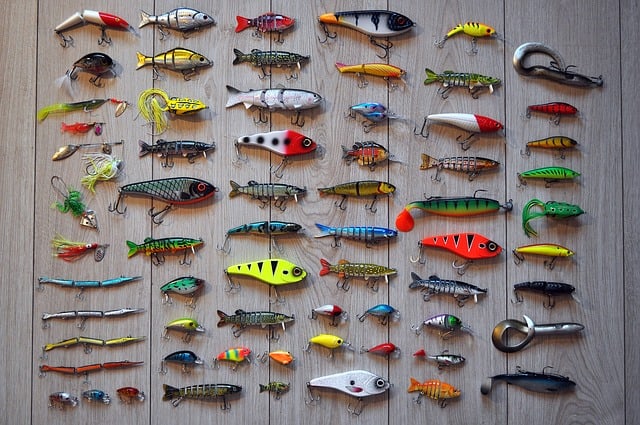
Artificial Lures: You can also use small spinner baits, or crank baits that represent small fish. These baits work good in wider parts of the river where the water is moving slower. These baits require lots of casting, so be sure to find a spot where you have enough open space to avoid getting your bait stuck in the trees.
Flies: Steelhead are less picky than their Rainbow counterparts. Probably because they live their lives in the lakes where they are exposed to a wider range of foods. They also stock up a healthy amount of fat before entering the river so they don’t necessarily need to feed, which means you will need to trigger them into biting a fly. Flies for Steelhead will generally fall into these three categories:
- Flies with materials that attract with color and action to trigger a response
- Dead drift imitations of eggs
- Dead drift imitations of invertebrates found in the river
How to Rig Your Bait for Steelhead

Slinkers: There are two main methods if you are using spawn sacs. The first is using slinkers. This is another item I’ve never heard of until I made some for this trip. The rig is set up to be used as a slip sinker, but instead of a lead sinker we use a slinker. The slinker is made by taking some paracord, removing the insides so all you have is the nylon outer layer. Then you shove BB’s into it until you get your desired weight. You will make many sizes. We made ones ranging from five BB’s to thirteen BB’s. This way you can easily adjust the weight to match the river conditions. The goal is to have just enough weight to sink your bait without getting caught up on the bottom. To seal it you just heat up the ends with a flame and them squeeze with a pliers. The nylon melts and makes a permanent seal. Then you poke a hole in the end so you can attach it to your line.
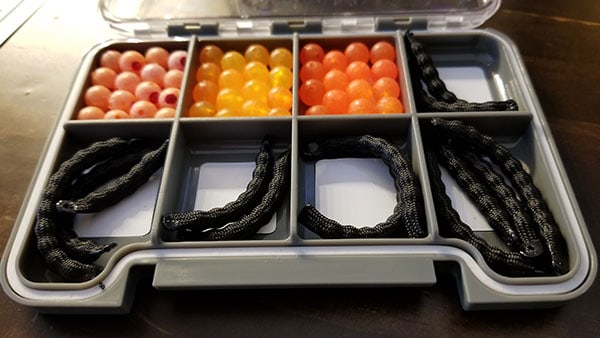
For your line set up, we were using 10 lb high visibility monofilament. Thread on a small snap swivel, followed by a small plastic bead, then tie a tiny barrel swivel. The snap swivel will be used to attach your slinker. The plastic bead protects your knot from the sliding snap swivel. Then tie about 3 feet of 6 lb fluorocarbon line to the other end of the barrel swivel. Finish it off with a number 6 or 8 hook. Take out a spawn sac and hook it right below the string that holds it closed and you’re ready to fish!
Bobbers: With bobbers, you will use the same method of casting upstream and letting the baits float down river. The advantage of the bobber is that it should keep your bait floating above the bottom to avoid snags. You will want to add weight to the bottom of the bobber to keep it floating upright. It can be difficult to tell when a fish strikes because the bobber will bounce under every time the hook grabs onto something and pulls it under. Whether you choose slinkers or bobbers, they both accomplish the same goal, so it’s more of a personal choice.
Waders for Fishing Steelhead
When I got invited to go fishing, I was asked if I had waders. I did not, so I looked up some waders on the internet and wasn’t sure if I wanted to spend hundreds of dollars on an item I may only use once. Then I went shopping at Walmart and just happened to walk by some waders prominently displayed on the end isle for only $14.99! I figured they would last at least one day, and then if I liked river fishing, I would spend the money on a good pair.
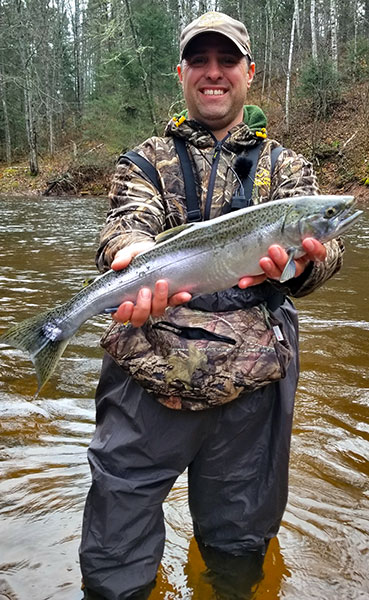
I quickly learned that you get what you pay for. I had to put up with the ridicule that my buddies gave me for looking like a complete novice out there, but it turns out, the joke was on them. They gave me an extra pair of neoprene waders they had so I wouldn’t look so silly, but I only got into the water over my ankle before my foot got wet, so my walmart specials saved the day. I did miss out on the first 30 minutes of fishing which turned out to be productive with a Steelhead and small rainbow trout.
Although my cheap waders did work, they had two major drawbacks. They weren’t very durable and after about two hours I wore a hole in the foot and water started coming in. Next, they are made out of vinyl which is not breathable at all. Luckily it was very cold out so I didn’t sweat. If you just want to go fishing for one day, then this is a very affordable option, but I will suggest getting a quality pair if you go more than once a year.

It turns out, my buddies expensive Simms waders were leaking too. He flipped them upside down and a half gallon of water poured out. He had a pair of good quality Simms breathable waders that were 6 years old. Apparently the material waders are made of doesn’t last very long. This lead us to do some research of finding the best pair of waders.
Here are some options to choose from:

- Rubber / Vinyl / PVC: These will be your cheapest options, but like I said, “You get what you pay for”. Good for occasional use and easy on the pocketbook.
- Neoprene: These are a good option for cold weather. They feel a bit like putting on a wet suit, since they are made of the same material. The thickness of the neoprene helps protect against cold temperatures. These are not breathable, so they may get a little hot and sweaty inside if you plan on fishing in the warmer months.
- Breathable: These will be your best all around waders. Generally breathable waders made out of materials like Gore-Tex, they are lightweight, easy to move in, and look nice. They will also be the most expensive option, especially if you want a high quality pair.
- Bootfoot: These can be any of the above waders that come with the boot permanently attached. The upside is that it comes with a boot so you won’t have to purchase it separately. The downside is that they are usually heavier in overall weight and can be bulky.
- Stockingfoot: These have a neoprene sock attached to the bottom of the wader. A dedicated wading boot, bought separately, is then put on over the sock. These waders are usually lightweight and can fold up smaller for storage. You can also change out boots while keeping the same waders.
My suggestion is to get a descent quality pair of breathable waders. $200-300 should get you there. You can spend upwards of $500 for a nice pair, but considering they don’t last forever, I would rather spend a little less and buy them slightly more often.
How to Dress for Steelhead Fishing
You will be fishing in the spring and fall, so it will be cold. Often there will still be snow and ice on the riverbanks in the springtime, and the water will be near freezing. Just like anytime you go out in cold weather, dressing in layers works best. Your base layer should be a lightweight breathable fabric to keep the sweat off your skin. Then an insulating layer. Finally an outer shell to protect you from the elements. You will want all this tucked inside of your waders, so make sure they are big enough.
Cotton is not recommended because it soaks up water and gets cold. If you can find clothing made out of wool, that would be best. Wool will still insulate and keep you warm even when wet.
Standing in the freezing water for more than 30 minutes will turn your toes ice cold even if you are dressed for it. The best option we found for keeping your toes warm is to use electric foot warmers. We found these on Amazon for $19.95. You will need to purchase a battery pack separately if you don’t already have one. They are durable and moisture proof. Justin was literally standing in water up to his boot tops and his foot warmers still worked! They put out 115 degrees of heat and will last 6+ hours with a standard battery pack.
Where to Fish for Steelhead
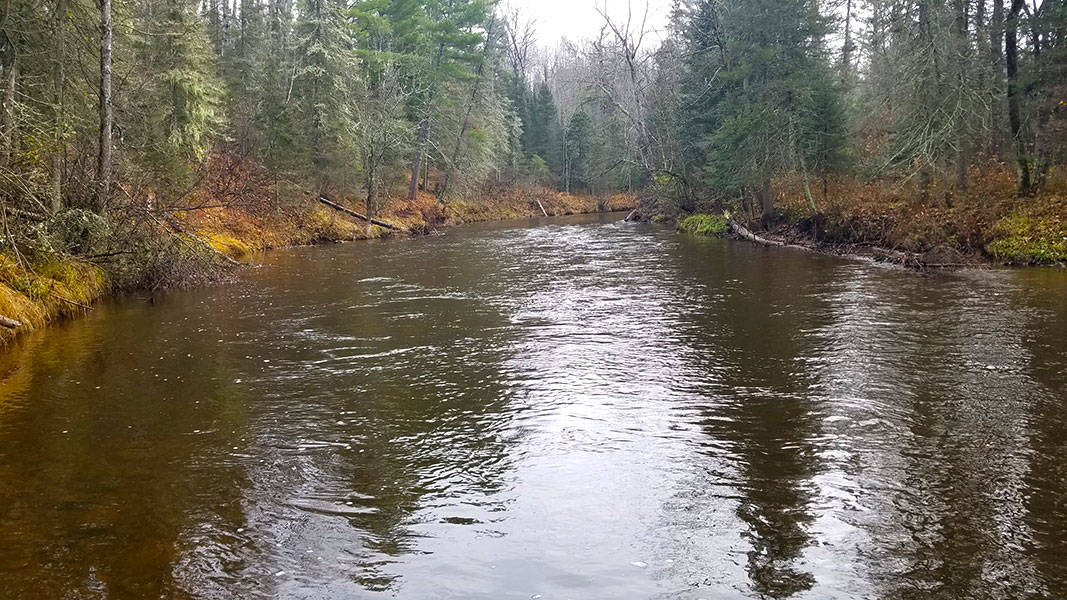
As we discussed earlier, Steelhead are Rainbow Trout that migrate from lakes or oceans into rivers to spawn. In our case, they come from Lake Superior, so any river coming off of Lake Superior should contain Streelhead. With that said, there are certain rivers that seem to produce more fish than others. The Brule river in Wisconsin is known as one of the best. It has been nicknamed the presidents river because five presidents have fished this river.
Etiquette on the River
Since it is one of the best rivers to fish, that means its popular among anglers. We were up at 4am to try and be the first ones on the water. We arrived well before sunrise but there were already four cars waiting at the trail head to the river. When it comes to fishing spots, it’s first come, first serve. You need to be the first one out there to secure your spot. We got to our spot about 10 minutes prior to legal fishing time and luckily only found one person there that was upstream just enough so we could fish our spot.
Eight Etiquette Rules to Consider:
- If you are not first to a spot, it’s not their problem. Find a different spot.
- Watch the direction others are fishing and don’t block them. Yield a couple of runs from them, especially if they are on the move.
- When in doubt, ask. “Do you mind if I fish here?”
- Tell others what your plans are. You can leave a note on your car saying where you are. Other anglers might head somewhere else of they know that spot is occupied.
- It’s great to get excited about a catch, but if you’re near other people, try to keep the celebration to a minimum to avoid ruining the fishing for everyone else.
- Follow the rules and regulations. If you do catch and release, try to take precautions to make sure the fish lives.
- Don’t camp in one spot all day. It may be the most productive spot on the river, but courtesy dictates you share with others.
- Just use common sense and don’t do anything that will screw up the fishing for someone else.
When to Fish for Steelhead
The Steelhead migration happens in the spring and fall, so this is when you will fish for them, but lets pinpoint exactly when the best time is. I found an excellent resource on the Wisconsin DNR website that does just that. Click here to view that document.
I will summarize what it says here. The DNR monitor the Steelhead run with digital video equipment. They are able to count, measure and record the time each fish goes up river. I’m not sure how they do this, but it yields some great info.
Information for the 2016-2017 run shows that most Steelhead arrive during the fall. The peak run occurred the second week of October. The Spring peak was late March (ice out). This was the second earliest date on record due to the warm air temps. While the spring migration tends to vary, the fall is fairly consistent.
The fall count was 5,544 fish. The spring count was 724 fish. As you can see, the fall has way more fish migrating. Total count is 6,268. The twenty five year average is 6,136, so it was not too far off average. Some other interesting statistics show that 23% of the fish equaled or exceeded the legal limit of 26 inches. Nearly half of all Steelhead were 20-25 inches long and weighed 3-5 pounds.
Summary
I bought a minimal amount of equipment for this fishing trip in case it was only going to be a one time thing. Now it is safe to say, I will be adding more equipment to my fishing arsenal, and here’s the reason why:
- It involves two sports I love, hunting and fishing. I get to walk through the woods as I sneak up to the river looking for signs of trout. Once I spot a trout or good spot, then I face the challenge of trying to hook one.
- Trout are beautiful fish. I’m amazed at how many colored stripes and spots each one has. They make Bass look ugly.
- It’s good exercise. We spend plenty of time walking along the river looking for good spots to fish.
- Photography. Besides fishing, I also do some photography on the side, and the scenery along the river is stunning.
- They are delicious! Trout have a much different flavor and texture than many of the other freshwater fish. When cooked over a campfire, it makes the experience that much better.
- It’s fun! Lets face it, if we didn’t enjoy it we wouldn’t be doing it.
See the Full Adventure Here
I hope this article was useful. I have many more helpful and interesting articles, so please feel free to browse around and take a look. I’m also building a library of the best lake reviews on the web. Check back often, as I’m constantly adding new lakes.
Thanks for reading, and good luck out on the lake.
